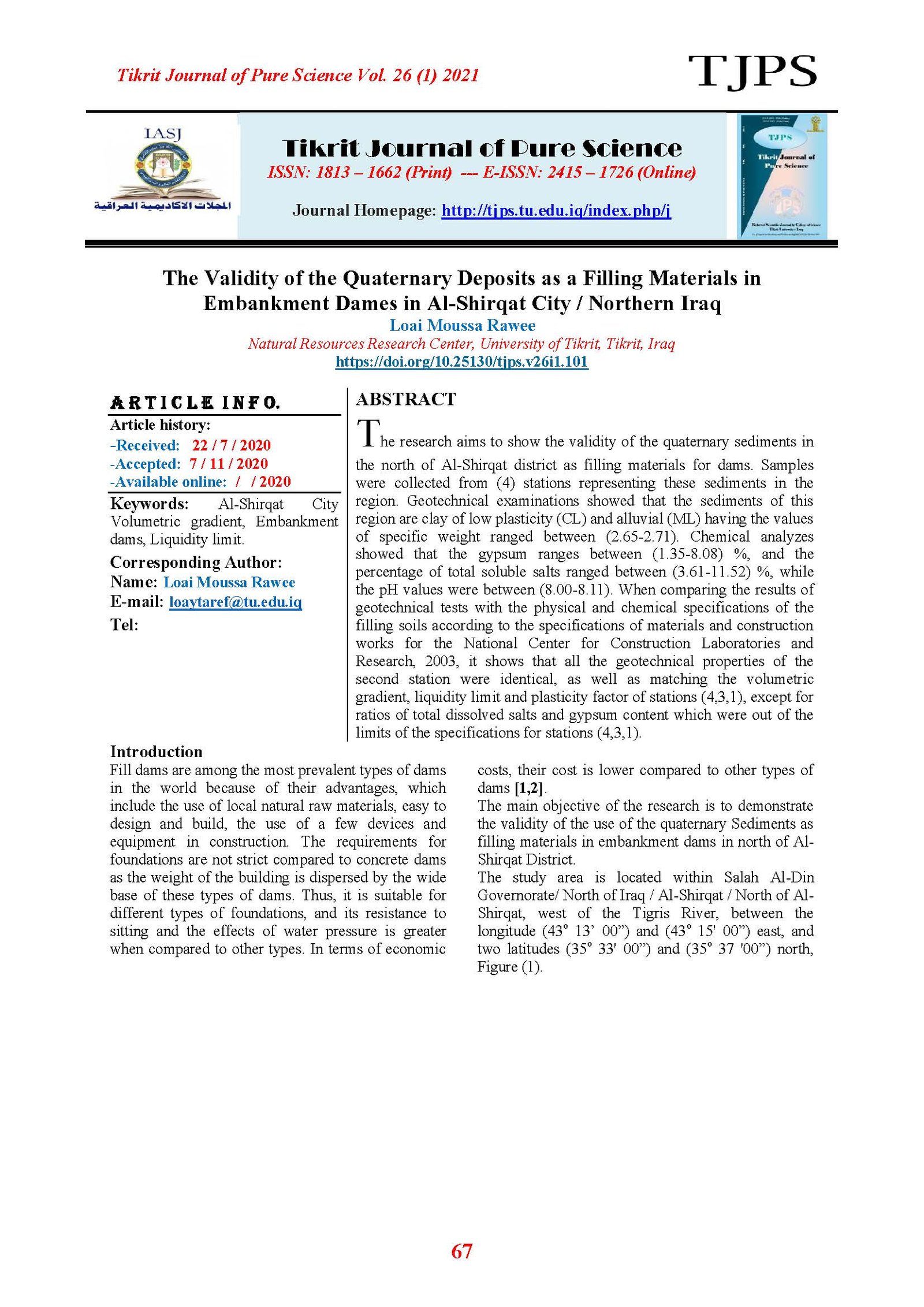The Validity of the Quaternary Deposits as a Filling Materials in Embankment Dames in Al-Shirqat City / Northern Iraq
Main Article Content
Abstract
The research aims to show the validity of the quaternary sediments in the north of Al-Shirqat district as filling materials for dams. Samples were collected from (4) stations representing these sediments in the region. Geotechnical examinations showed that the sediments of this region are clay of low plasticity (CL) and alluvial (ML) having the values of specific weight ranged between (2.65-2.71). Chemical analyzes showed that the gypsum ranges between (1.35-8.08) %, and the percentage of total soluble salts ranged between (3.61-11.52) %, while the pH values were between (8.00-8.11). When comparing the results of geotechnical tests with the physical and chemical specifications of the filling soils according to the specifications of materials and construction works for the National Center for Construction Laboratories and Research, 2003, it shows that all the geotechnical properties of the second station were identical, as well as matching the volumetric gradient, liquidity limit and plasticity factor of stations (4,3,1), except for ratios of total dissolved salts and gypsum content which were out of the limits of the specifications for stations (4,3,1).
Article Details

This work is licensed under a Creative Commons Attribution 4.0 International License.
Tikrit Journal of Pure Science is licensed under the Creative Commons Attribution 4.0 International License, which allows users to copy, create extracts, abstracts, and new works from the article, alter and revise the article, and make commercial use of the article (including reuse and/or resale of the article by commercial entities), provided the user gives appropriate credit (with a link to the formal publication through the relevant DOI), provides a link to the license, indicates if changes were made, and the licensor is not represented as endorsing the use made of the work. The authors hold the copyright for their published work on the Tikrit J. Pure Sci. website, while Tikrit J. Pure Sci. is responsible for appreciate citation of their work, which is released under CC-BY-4.0, enabling the unrestricted use, distribution, and reproduction of an article in any medium, provided that the original work is properly cited.
References
[1] United States Society on Dams (2007) "Strength of materials for embankment dams, Denver, United States of America, p.p.27.
[2] Stephens, Tim (2010), "Manual on Small embankment dams, Aguide to Siting design and construction", FAO Irrigation and Drainage Paper, Roma, p.p.115.
[3] Buday ,T., (1980): The Regional geology of Iraq (Stratigraphy Paleontology) Dar AL- Kutib publishing House ,Mosul, Iraq, p.p.443.
[4] Bowles, J. E., (1984): Physical and Geotechnical Properties of Soil, 2nd ed, McGraw Hill Japan Ltd. p.p.578.
[5] ASTM- D, 854-02., (2004): Standard Test Methods for Specific Gravity of Soil Solids by Water Pyknic meter.
[6] ASTM-D, 422-63., (2004): Standard Test Method for Particle-Size Analysis of Soils.
[7] ASTM. D-421, 2004, Standard Practice for dry preparation of soil samples for particle size analysis and determination of soil constants.
[8] Keystone, (2003): Silt and Soils-Atterberg Limit, Keystone Retaining wall system.
[9] ASTM, D 4318-00., (2004)" Standard Test Methods for Liquid Limit, Plastic Limit, and Plasticity Index of Soils "
[10] ASTM-D, 2487 - 00., (2004): Standard Practice for Classification of Soils for Engineering Purposes (Unified Soil Classification System).
[11] Handbook No.60, (1959), " Diagnosis and Improvement of Saline and Alkali Soils, Agric.", US Department of Agriculture (USDA), Washington, D.C.
[12] National Center for Laboratories and Construction Research (2003), “Specifications for materials and construction works No. (SORB R5), General Specifications for Roads and Bridges, Earthworks”.
